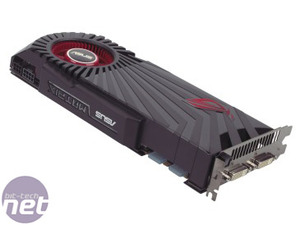Asus Matrix GTX285 Review
Manufacturer: AsusUK Price (as reviewed): £279.99 (inc VAT)
US Price (as reviewed): $359.99 (ex Tax)
It's well known amongst car enthusiasts that you can't consider yourself a true petrolhead unless you've owned an Alfa Romeo. It's a strange perception that plays on the fact they supposedly have a character all of their own. At least that's what those who have owned them think but there's plenty of people who dispute this of course.
In any event, if there was a range of motherboards that had a similar stance in the PC enthusiast industry, it would have to be Asus' Republic of Gamers (ROG) series. Usually ROG signifies that a piece of hardware has received that additional touch, that bit of extra attention with regards to performance. The term 'gone the extra mile' also comes to mind.
Motherboards like the Blitz, Maximus and Rampage in particular usually guarantee great overclocking as well as providing the extra cooling and power circuitry to go with it. We've had few situations where this wasn't the case so when an ROG branded graphics card lands in our labs we were unsuprisingly keen to get it into one of our test systems. Indeed the Asus Matrix GTX285 has a features line up to compete with the best air cooled GTX 285s out there.
Firstly though a quick look at the package. As you'd expect from a premium graphics card that retails for a fair bit more than a generic version, the box is pretty swanky and has the customary flip lid you'd be familiar with if you've owned and ROG motherboard. In the box the most notable inclusion is an attractive optical disk wallet with the usual DVI to D-Sub adaptor, DVI to HDMI adaptor, HDTV-out cable, PCI-E to molex adapter and S/PDIF cable thrown in too.
While the Asus Matrix GTX285 might look like a vanilla example of Nvidia's fastest single core graphics card, there's more going on than meets the eye. What might sound strange though is that it's barely overclocked as standard. Nope you heard that right. It sports a slightly bumped 662MHz core but the standard 1,476MHz shaders and 2,484MHz effective memory speeds. What it can do however is dynamically increase or decrease these clock speed depending on load with profiles and plenty, actually plenty is probably the wrong word, more like bucket loads of tweaking options available for some ulta fine tuning. BIOS flashing, memory timing and voltage adjustment, they're all here. More on these features in a minute.
The bulge in the side of the Asus Matrix GTX285 is part of a load sensitive LED indicator which makes up a backlit Matrix logo. This goes through five different colours depening on how much stress the graphics card is under with red meaning high load and green meaning idle. It's actually looks quite good and should look great through side windows.
On the top side of the PCB is what Asus calls a Super ML Cap. This features a very low ESR which stands for Equivalent Series Resistance and is the term given to the resistance of the capacitor, the lower the better. In graphics cards, Asus claims a high quality example such as this improves overclocking capability. Our first thought however was something along the lines of oooh shiny.

MSI MPG Velox 100R Chassis Review
October 14 2021 | 15:04















Want to comment? Please log in.